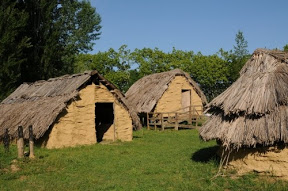
In 1990 it was discovered this archaeological site, called the Draga, corresponding to an ancient Neolithic village next to Lake Banyoles, and created around the year 5000 BC. It is the only lake village preserved throughout the Iberian Peninsula and here have been found hundreds of sticks used as pillars of the huts that were established here. Some of these huts have been rebuilt for curious visitors. Guided tours and workshops for children on creating tools of the time are organized.
Draga Neolithic Village Map
- Apartments(1)
- Villas(1)
- Hotels(5)
- Nature reserve(2)
- Museums(2)
- Iberian sites(1)
How to arrive to Draga Neolithic Village?
How to arrive from:Draga Neolithic Village Photos
Other interesting places near here
-
 1.1 miles away
1.1 miles awayRomanesque church located near the Banyoles lake and consecrated in the twelfth century. Access to it is very easy, since it is next to the road, and has parking. From simple portal, the interior reveals that the main apse is formed by several little apses and two side chapels. There's a triumphal at the entrance to the chancel. To the right of the this little church is the rectory, and left the cemetery, with graves of past centuries, and a small covered space called comunidor, where in ancient times the priest blessed the four winds to wish for a good harvest.
... -
 2.6 miles away
2.6 miles awayClot d'Espolla is a temporary pond formed in the north of Lake Banyoles, less than 2 kms from it, and that feeds from some springs under the rocks in its basement. Under these holes goes out overflowing groundwater from the mountains of the region of high Garrotxa, north-west. That is why we find it in its glory in the rainy season and is dry in summer. This pond also raise the triops cranciformes, some crustaceans whose eggs are kept in the mud for months and who develop in the rainy season, when they grow until to 2 or 3 cm.
... -
 3.3 miles away
3.3 miles awayVilauba Roman Villa is located just over 1 kilometer south of Lake Banyoles, in the village of Camós, and was occupied between centuries II BC until the VII century A.C. Some objects and little statues that have been found here are showed in the Archaeological Museum of Banyoles, where guided tours are organised to visit this place. The site is fenced but it is visible clearly from the road. Of the remains preserved we infer that this villa was dedicated to make wine and olive oil.
...

